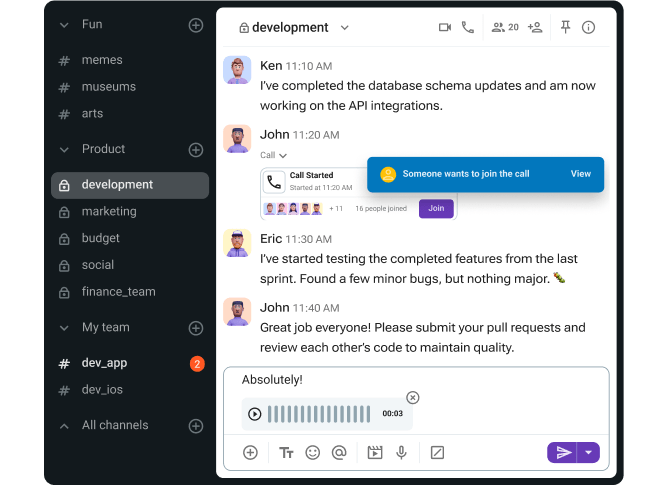If you’ve ever opened your team communication app on a Monday morning and felt overwhelmed with the amount of unread messages and channel pings, you’re not alone.
When team chat is our primary communication lifeline, it’s easy for important information to get swept away in the current.
That’s where the concept of “workspace hygiene” comes into play. It’s this simple idea that your communication tool should be as organized as your desk — probably more so, considering how much of your day happens inside it.
When your digital environment is intentionally structured, you waste less time hunting for messages or switching channels. Instead of reacting all the time and playing catch-up, you switch to focus.
And if you’re looking to build that smooth-flowing productivity in Pumble — a team communication app — I’ve got you covered.
Below are the 3 best Pumble tips for easier work, designed to help you:
- Organize smarter,
- Communicate faster, and
- Turn your communication app into a reliable command center instead of a noisy notification stream.
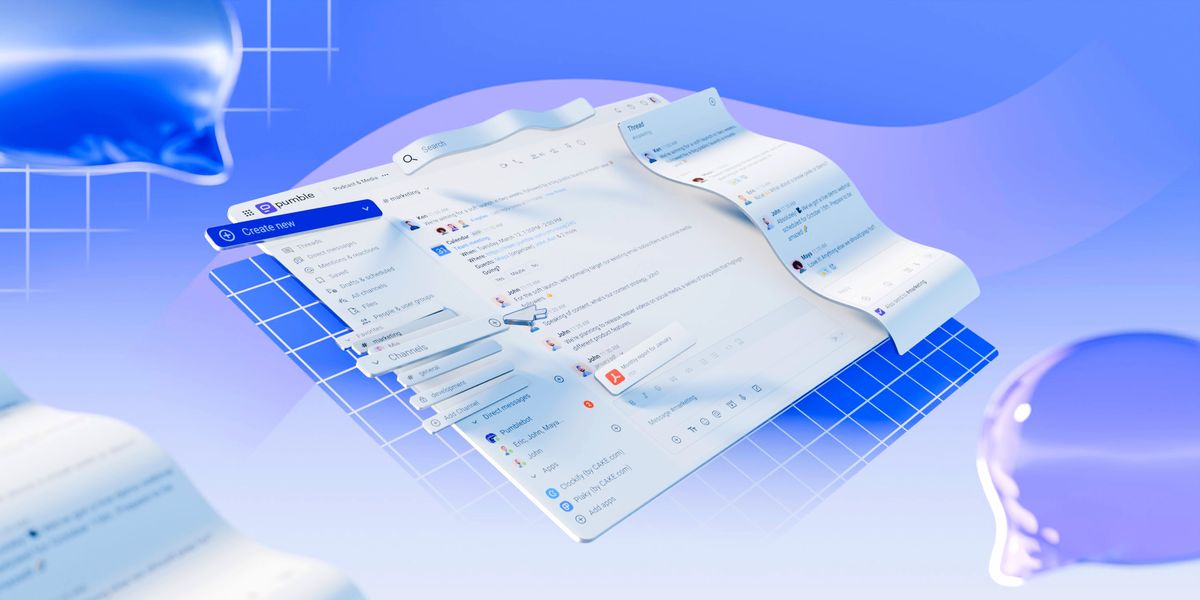
Tip #1: Tame the chaos by organizing your sidebar
A cluttered sidebar is basically the digital equivalent of having piles of papers across your entire desk. You can get things done, but not without a lot of effort to make some sense of your chaotic workspace.
Most people leave their Pumble sidebar as the default, alphabetical list, and that’s totally fine if you only have a handful of channels.
But once you’re juggling multiple projects, collaborating with several teams, or hopping between company-wide groups and private channels, alphabetization just doesn’t cut it.
This is where Pumble custom sections step in to save the day.
Why custom sections matter
Custom sections in Pumble let you organize channels in a way that mirrors how your brain organizes work, not how the alphabet does it. Whether you prefer grouping your conversations by priority, project, team, or workflow stage, Pumble’s custom sections let you decide.
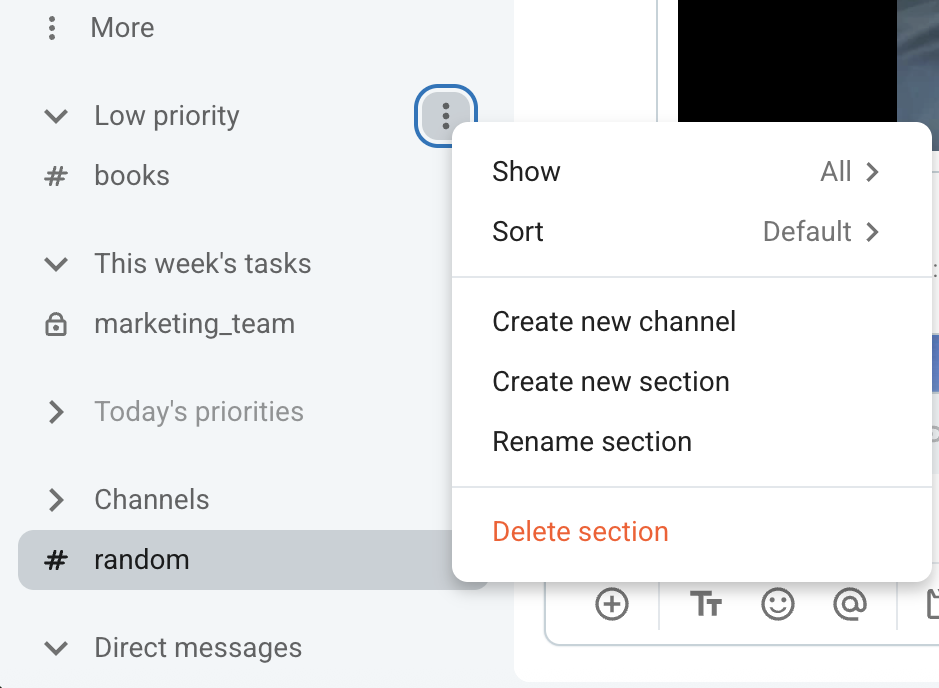
Organize Pumble sidebar by project
If you’re a project manager, designer, developer, or anyone handling multiple initiatives at once, you might benefit from categorizing your sidebar by project.
You can create sections like:
- Website redesign,
- Q4 Marketing campaign, and
- Client accounts.
Now you can have all your related channels — #design, #dev_support, #client_feedback, #approvals — stacked neatly together.
Organize Pumble sidebar by priority
Do you need to stay laser-focused on your goals and avoid distractions? Organizing Pumble sidebar by priority is ideal for you, as it offers a clear overview of your priorities.
You can try adding sections such as:
- Today’s priorities,
- This week’s tasks, and
- Low priority.
Moreover, you can move your Pumble channels between sections as priorities shift. Organizing your Pumble sidebar by priority leaves the guessing out of your prioritization, as your sidebar tells you what to tackle first.
Organize Pumble sidebar by team or department
This type of Pumble sidebar organization is useful for people involved in cross-functional collaboration.
For example, you can set up custom Pumble sidebar sections for different departments you work with:
- Engineering,
- Sales and Support, and
- HR.
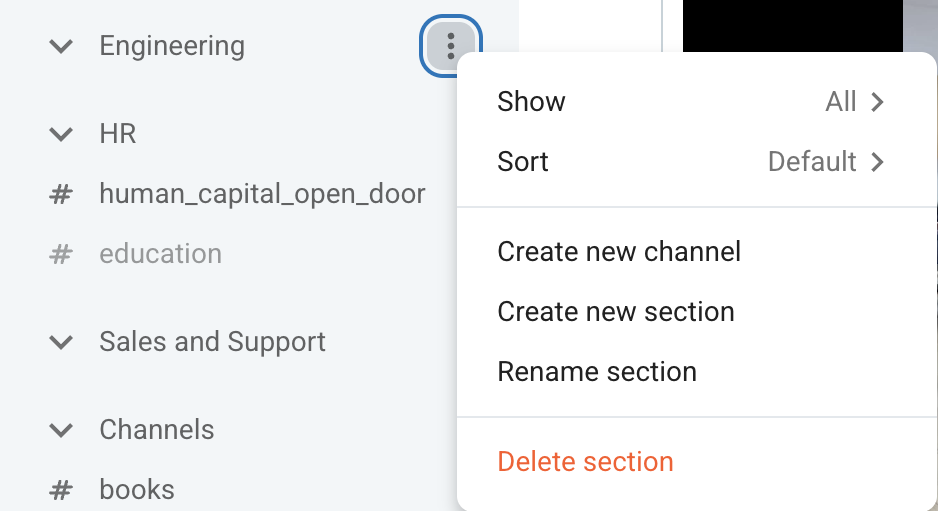
Organizing your Pumble sidebar by team is like giving it a proper tidying up where every conversation has its logical place.
Organize Pumble sidebar for workflow optimization
If you prefer categories that reflect the stages of your workflow, try adding sections like:
- Research,
- In Progress,
- Approvals, and
- Completed projects.
This type of classification naturally supports workflow optimization and helps you manage Pumble channels with less friction.
Whatever method you choose, custom sections in Pumble transform your sidebar from a scroll-heavy to-do list into a crystal clear control panel.
Tip #2: Never lose context with “saved items” and pins
As a modern-day professional, I’m sure you’ve found yourself wondering where that one important message was more than once.
Messages move quickly in busy channels, which makes their retrieval close to impossible.
Pumble solves this with two powerful features:
- Pinning and
- Saved items.
And while they sometimes get lumped together, they actually serve completely different purposes, and knowing the difference is key for improving team communication productivity.
Pinning messages: Shared, persistent, and channel-wide
Pinning is for messages everyone in the channel should be able to find easily.
Think of pinned messages as the channel’s command board in a way.
You’d use them for:
- Guidelines,
- Key documents,
- Important links,
- Meeting notes, and
- Regularly referenced instructions.
Pinned messages in Pumble help maintain channel-wide clarity. Anyone who joins the channel later can quickly get up to speed, without scrolling endlessly through message history.
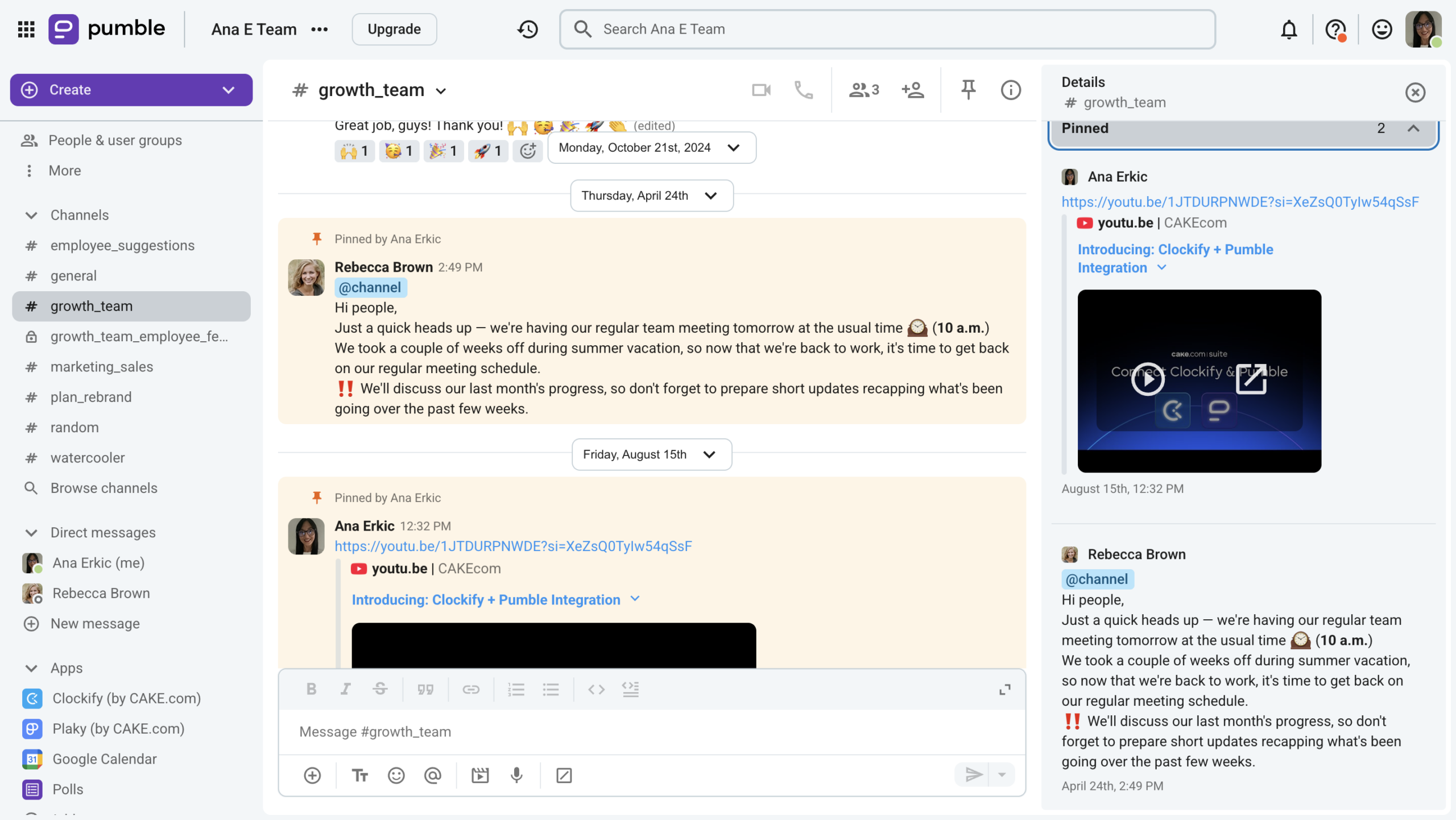
Saving messages: Your personal to-do tracker
Saving a message is your private “don’t forget this” tool. Saving puts that message into your personal collection, no matter which channel it came from.
You can save:
- Tasks assigned to you,
- Messages you need to reply to later,
- Files you want to read, and
- Notes you don’t want to lose track of.
This feature helps you save messages in Pumble without cluttering your brain, or the channel, for that matter. Nobody else sees what you choose to save, making it the perfect personal productivity mechanism.

So, in a sense, pinning is for everyone, while saving is only for you.
Tip #3: Navigate at lightning speed with keyboard shortcuts
Let’s be honest, as helpful as a mouse is, it can also slow you down in a major way. Clicking from channel to channel might not seem like a big deal, but multiply it by your daily message load and, suddenly, you’re losing precious minutes.
Enter Pumble keyboard shortcuts.
These shortcuts are like the secret doors to everything you need. Once you get the hang of them, you’ll fly through your workspace faster than ever.
Handy Pumble shortcuts worth memorizing
The star of the show is the quick switcher activated with: “Ctrl/Cmd + K”.
This Pumble shortcut instantly opens a small search bar where you can type the name of:
- A conversation,
- A channel, or
- A teammate.
No more scrolling. No more hunting. Just type a command and jump straight to your intended message.
It’s perfect for anyone who juggles a lot of channels or frequently switches between conversations.
Other handy shortcuts include:
- Ctrl/Cmd + Shift + A — Jump to all unreads,
- Ctrl/Cmd + / — Open the full shortcuts list,
- Ctrl/Cmd + F — Search within a conversation,
- Ctrl/Cmd + Shift + F — Use advanced search filters across the workspace,
- Ctrl/Cmd + N — New message,
- Ctrl/Cmd + Shift + M — Set up a new meeting (desktop),
- Ctrl/Cmd + Alt/Option + Shift + M — Setup a new meeting (Web),
- Ctrl/Cmd + Alt/Option + A — Start audio recording.
These Pumble shortcuts give you quick navigation without lifting your hand from the keyboard. Before long, you’ll wonder how you ever worked without them.
Communicate faster with Pumble
How smart features create a smoother workflow
Any tool is only as good as how you organize it.
Even the most powerful digital platform can feel chaotic if you don’t leverage its structure. The way modern-day nonstop communication works can make critical files and key messages disappear. Moreover, your deep work momentum goes out the window when you’re switching between 20 channels.
It’s no wonder teams often feel overwhelmed due to information overload. According to research by Gartner, 27% of employees and 38% of managers report feeling overloaded by the volume of information they receive daily.
Without a clear structure, communication apps turn into broken filing cabinets:
- Messages scatter across different threads,
- Files vanish under waves of conversation,
- Channels multiply without any sense of hierarchy, and
- You waste time clicking, searching, and recovering lost content.
This constant friction chips away at your team’s focus and slows everyone down.
Pumble takes a different approach designed for retrievability. Instead of behaving like a simple notification stream, it gives you the tools to build a workspace that fits your mental model and helps improve team communication and productivity.
Pumble’s standout features making this happen include:
- Custom sections — for intuitive sidebar structure,
- Saved items and pins — for fast and personalized message retrieval,
- Robust search and search filters — for locating files, messages, or conversations instantly, and
- Keyboard shortcuts — for smooth, speedy navigation.
Together, these features turn Pumble into more than an internal communication software. It becomes an organized knowledge base.
With Pumble, you’re no longer just reacting to notifications. Instead, you’re proactively shaping your digital environment, making it easier to focus, prioritize, and collaborate.
When digital communication moves at insane speed, your workflow needs to keep up. With the right setup and Pumble best practices, you can transform your day-to-day collaboration.
Organize your work better with Pumble
At the end of the day, digital communication doesn’t have to feel draining. With a little structure and a few smart habits, you can create a workspace that works for you, not against you.
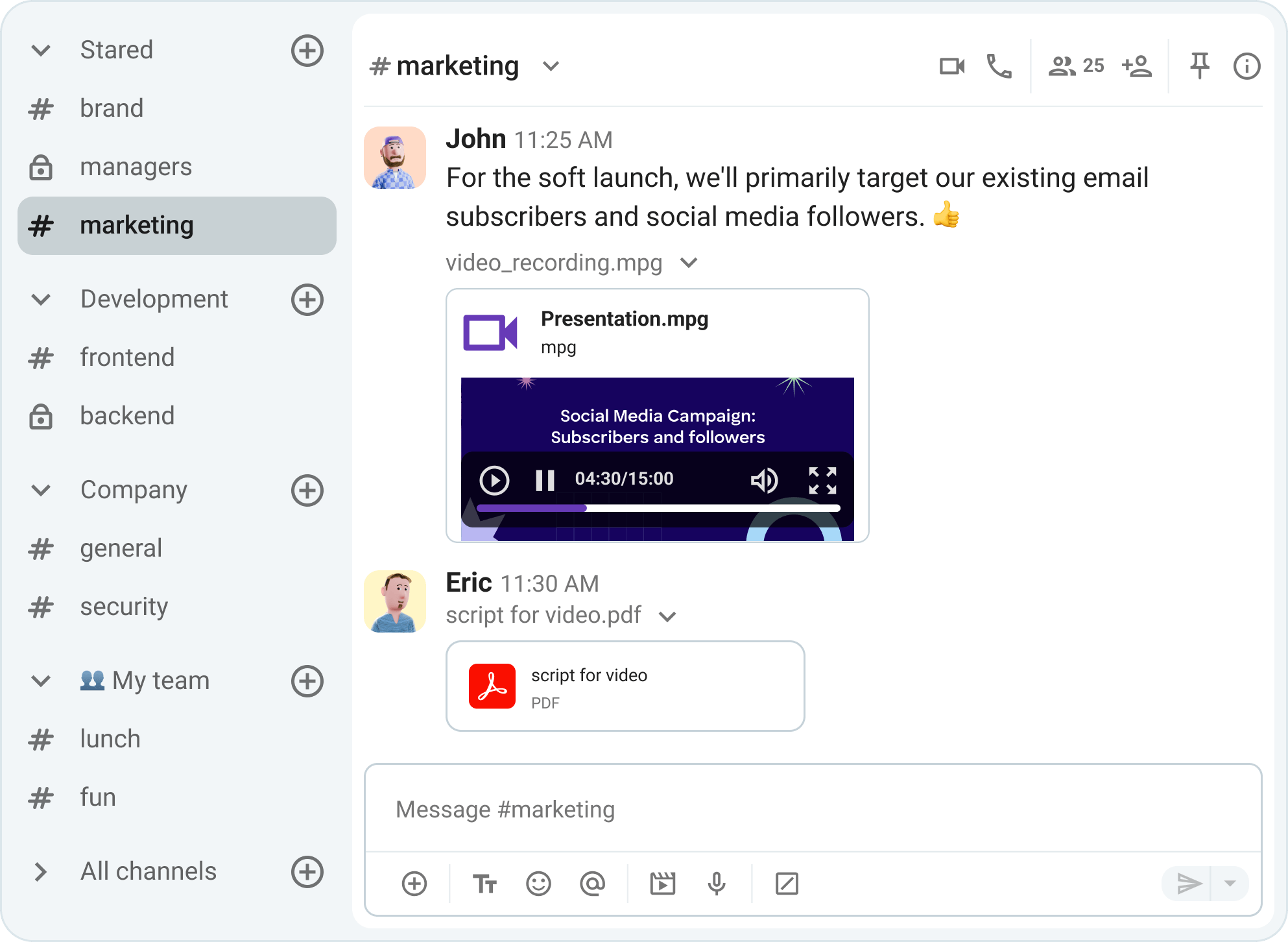
So, take a few minutes today to:
- Tune up your sidebar,
- Save the messages that matter,
- Pin the ones your team needs, and
- Start navigating like a pro.
Your future self and your team will thank you.
Build a better workspace with Pumble
Comment nous examinons cet article : Nos rédacteurs et éditeurs vérifient les articles et les mettent à jour lorsque de nouvelles informations sont disponibles, afin qu'ils soient toujours d'actualité.
